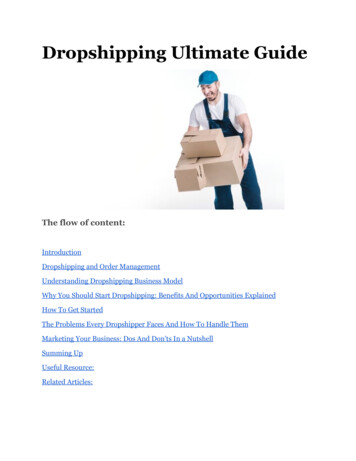
Transcription
THEULTIMATE GUIDETOBLOGGING
THE ULTIMATE GUIDE TO BLOGGINGINTRODUCTIONWelcome to the Ultimate Guide to Blogging! Whether you’re new to the game or amore experienced content connoisseur, this guide will give you the practical advice youneed to help manage your blogging efforts throughout each stage of its lifecycle. Fromcreating your blog – to gathering stellar content – to leveraging and distributing yourposts for maximum impact, we’ve got the tips, case studies and tools you need to buildand maintain a successful blog that benefits you and your business. Plus, we’ve added insome industry insights to help you better understand the role blogging plays in your overallcontent marketing strategy, and how other businesses are investing in, and practicing, thiscritical content activity.Enjoy!Joe PulizziFounderContent Marketing Institute@juntajoe*Disclaimer: While some content in this guide describes how B2B marketers can benefit fromblogging, we’ve also included B2C insights and believe that many of the tactics covered here canbe applied across both.2
THE ULTIMATE GUIDE TO BLOGGINGTABLE OF CONTENTS1Blogging 1012Blogging Stats, Facts & Insights (and what they mean to you)3Calculating the Costs of Having Quality Content on Your Blog4Getting Started: How to Build Your Blog and its Content Strategya. The 10 Things Every Company Should Do Before Bloggingb. Choosing Your Writing Style5Time to Write! How to Create Stellar Content in Each and Every Posta. Basics and Best Practicesb. Post Typesc. Attention-Grabbing Headlines6Promoting and Leveraging Your Posts for Maximum Content Exposurea. 12 Things to Do After Postingb. How to Leverage Your Post Content7Measuring Success (21 Blog Metrics)8Appendixa. Resources and Tools Libraryi. 22 WordPress Pluginsii.B2B Blogging tipsiii.10 Must-Have Content Marketing Templatesiv.10 Blogging Tips for Beginners and Experts3a. 12 Reasons to Start Bloggingb. Companies Doing Blogging Right (Case Studies)
THE ULTIMATE GUIDE TO BLOGGINGSECTION 1Blogging 101Before we take a deep dive into the exciting world of blogging, let’s take a step back and discuss some fundamentals.What is a ‘Blog’? Shorthand for “Weblog,” a blog offers an easy way to present brief chunks of frequently refreshed Web content. Backed with easy-to-usetechnologies for syndication (e.g., RSS), comments and trackbacks, blogs are often the blazing centers of social media solar systems that can incorporatesophisticated SEO strategies and community-building campaigns.Even in the age of social media, CMI contributor Heidi Cohen argues that blogs are still a vital content marketing activity, now more than ever:“Blogs no longer get the same buzz as their newer social media cousins, Facebook and Twitter. That said, blogs are at the heart of social media,especially if you’re involved in content marketing because blogs supply the content that drives social media conversations.” (Heidi Cohen)Now, blogging isn’t for everyone. To know if it’s right for you, here are some high-level “Hot or Not” guidelines:A HOT TOOL FOR.NOT-SO-HOT FOR. Businesses eager to build communities around relevant issues/topics Companies that cannot be open with information Using the blog as a repository for your social media strategy Organizations without the necessary time, talent or expertise Improving search engine rankings (search engines LOVE blogs!) Businesses who do not like to experimentFor those of you who the “Hot” column screamed your name –congratulations! You will likely benefit from building or enhancing your company’s bloggingefforts. (For those of you in the “Not so Hot” column, we may recommend trying out some of the many other content marketing tactics outlined in theContent Marketing Playbook).4
THE ULTIMATE GUIDE TO BLOGGINGBlogging Stats, Facts & Insights(and what they mean to you)Regardless of how much, or little, your company invests inblogging, it’s important to see how your activities comparewith other companies. Here’s a snapshot of the current“state of the industry” for blogging from 2012 (basedon findings from the B2B Content Marketing 2012Benchmarks, Budgets and Trends Report).B2B Content Marketing Usage (by Tactic)79%Articles74%Social Media (other than blogs)65%Blogs63%eNewslettersFact 1: Blogging is on the Rise – For Almost Everyone:Blogging has been a steadily increasing practice for mostcompanies over the past few years, regardless of size,specialty and location. 2011 was no exception, as B2Bmarketers increased their use of blogs by 27%, makingblogs the 3rd most common Content Marketing activity(behind articles and social media).58%Case Studies56%In-Person EventsVideos52%White Papers51%46%Webinars/WebcastsWhat this means to you:If you’re not blogging already, and you have the capabilitiesto do so, you should seriously consider it – because yourcompetitors probably are, too.Microsites31%Print Magazines31%Traditional Media30%Research Reports25%Branded Content Tools 22%Print Newsletters 20%eBooks16%Podcasts16%Mobile Content 15%Digital Magazines 14%10%Virtual Conferences05102030405060708090100
THE ULTIMATE GUIDE TO BLOGGINGFact 2: Company Size Matters: 68% of companies with 10 – 99 employees maintain a blog, with only 55% of the largest companies employingthis tactic. This may be due to the fact that blogging is a relatively simple, low-cost content activity that can have significant SEO and lead-generationbenefits if done right. And, as a powerful inbound marketing tool, your blog can serve as the magnet that draws customers to your site, eliminating theneed of more expensive or time- consuming investments like customer communities or white papers.What this means to you:If you have a lean department with even leaner budgets, you may want to consider using your blog as the core pillar of your online marketing strategy.Fact 3: Companies are Getting More and More Confident in Their Blogging Capabilities: While in-person events and webinars are still perceivedto be the most effective content marketing tactics, on average, blogging experienced a 45% increase in how effective marketers felt the practice was.What this means to you:If you haven’t started blogging and feel overwhelmed by the thought of it, don’t fret. It gets easier, and in a relatively short period of time you will alsolikely feel that it’s becoming more effective. Practice makes perfect, right?What does all this research mean? It means that the case is there for you to begin or enhance your blogging activities, because most other companiesin the marketplace are doing so in increasing numbers. Why? Because as we’ve touched on in the statistics above, blogs are extremely powerful, lowcost and can meet many of your content marketing needs in one shot. As Heidi Cohen states in the article: “12 Reasons to Put Blogs at the Centerof Your Content Marketing”:Blogs are so popular because they are the optimal choicefor your content marketing hub – acting as contentchameleons that combine the strength of social media withold-fashioned print-publishing functionality. The reality isthat in today’s content-driven world, while you may viewyourself as a marketer, you’re really a publisher. You mustprovide relevant content for your prospects, customers andthe public who – according to Ipsos’ research – spend over10 hours a day consuming media.6
THE ULTIMATE GUIDE TO BLOGGINGTo break it all down, here are the top 12 reasons why your company should invest in blogging, or take your current blogging activities to the next level.Oftentimes these reasons are also used as the starting point for convincing your executives to make an investment in blogging:1. Blogs are an easy-to-use CMS (aka content management system). Blogs require limited training and/or technical skill to use whileproviding flexibility to update or modify content quickly. As an added bonus, blogs are inexpensive.2. Blogs are part of a company’s owned media. Blog content is owned by your organization and can be integrated into your website. Unlikeother third-party and social media outposts, you don’t need to worry about whether they’ll disappear or go out of business. A blog can serve in lieuof a website.3. Blogs provide branded context for your content. As part of your firm’s owned media, blogs offer a branded context for your communicationsthrough the use of blog design elements that can be exported with the content. You can extend your brand without paying for third party media.4. Blogs integrate your brand into your content marketing. Beyond the blog’s branded context, blogs create a blog personality with a uniquevoice. They offer communications transparency and the opportunity to write in a conversational tone that makes your brand feel “human”. Just besure to avoid content that is clearly self-promotional, and ensure your blog personality is integrated with your brand personality across other socialmedia platforms.5. Blogs enhance search optimization. Through their keyword-rich content, architecture and cross-linking to other content on the Web, blogssupport search optimization efforts. (Note: This assumes you’re using your own domain not a free third party blogging platform.)6. Blogs are a 24/7 communication platform. With increased need for real-time communications, blogs are a great place to quickly publishfavorable content about your brand or respond to evolving issues. Plug-in software can automate your editorial calendar.7. Blogs support an array of media formats. For distributing branded content, blogs simplify the uploading and management of text,photographs, graphics, videos, audio, presentations and PDFs. When creating offline content and events, consider what kind of online content cango on your blog.8. Blogs facilitate content distribution through multiple channels. Blogs can expand your message delivery through email and RSS feedsat no additional cost. Blog posts can also be automatically collected into email digests.7
THE ULTIMATE GUIDE TO BLOGGING9.Blogs supply content for social media interactions. Blog content is currency for social media engagement on social sharing sites such asTwitter and Facebook. Make sure to include icons and tailored calls-to-action. (Remember, these shares translate to earned media impressions(aka free.)10. Blogs provide a targeted location to direct prospects and customers. With a URL or QR code you can direct prospects, customersand the public to your blog from other forms of content marketing. This gives you a way to connect the various components across platforms.11. Blogs are flexible enough to support diverse initiatives. Blogs can help companies achieve a variety of corporate goals, such as providingproduct-related content, answering customer questions, attracting new prospects and hosting an executive platform.12. Blogs provide metrics that you can use to track content marketing to business goals. As with any business strategy, it’s critical tomonitor your progress. There are a variety of metrics to assess your blog’s effectiveness, which we will cover in more detail in this guide.To sum up, putting a blog at the center of your contentmarketing strategy is a sound idea. It provides a brandedenvironment that’s optimal for your content and alignedwith your corporate goals. Even better is the flexibility thatblogs provide and their ability to be integrated into yoursocial media strategy.8
THE ULTIMATE GUIDE TO BLOGGINGCalculating the Costs ofHaving Quality Content on Your BlogCalculating the cost of your blog is a challenging task as it’s very dependent on the types of platforms you use or resources you employ (for example, manystandard Wordpress themes are free while other complex content management systems may be very expensive). These costs can vary greatly from companyto company depending on your needs, location, or size, so rather than getting too granular, let’s start with the basics: The content creation. Here’s an overviewof how and why you should consider making room in your budget for high quality content creation for your blog (originally posted by Joe Pulizzi in “HowMuch Should Brands Pay for Content Marketing?”)When most marketing professionals budget for content, whether it be for web content, blogs, editorial for print magazines or eNewsletters, they go by what“feels” right. Marketers inherently judge content pricing based on what they’ve paid for PR or other creative, or even the value of their own time. Contentand copy are always subjective and there are always multiple steps. But the starting point is the Content Goal. If your goal is to create high-quality, thoughtleadership-driving content, then you may want to consider shying away from “cheaper” tactics, which may often include re-writes, content curation or lowerquality writing. Though the price tag may be lower, using this model is dicey at best. Why? You have a unique voice and your content needs to portray that. Getting writers to understand your voice takes time and expertise. You have a marketing plan that has specific goals that need to be addressed. That means the content created has to speak directly tothose goals. This takes time and expertise. Your content needs to original, engaging, valuable and compelling. Developing this kind of content takes time and expertise.Having a more experienced, high-quality content contributor allows you to write content that meets these important objectives, helping you lead theconversations with your customers and ultimately help your business profit from the content you create.Note: If you want more specific, tailored cost estimations, we recommend this blog post by Jay Baer titled, “Calculating Your Blogging ROI in 9 Steps”which contains detailed formulas for determining your blogging costs and revenue, and how to determine what your ROI could be (you may want to grab acalculator, pencil and paper if you go down that road )Now that we’ve covered the basics, let’s discuss the fundamentals of your blog and how to establish what kind of contentyou’ll need to make it successful.9
THE ULTIMATE GUIDE TO BLOGGINGGetting Started: How to Build Your Blogand Its Content StrategyWhether you’re considering starting a company blog, or want to revamp the one you already have, there are 11 standard elements and practices eachcompany should implement from the very start (with highlights from Heidi Cohen’s article “Must-Haves for Company Blogs.”)Determine Your Blog’s Business ObjectivesBefore you jump in and get someone in your web department to develop your blog site, take some time to think through the major strategic elements. This isa critical step to ensure your blog is in line with your brand and/or company objectives. Among the top business blog goals are to: Build the brand by providing content to support your offering. This information should engage prospective customers. Expand reach by offering prospective buyers solutions to their product needs though a variety of content forms such as checklists and how-to videos. Support sales by giving potential buyers useful information. The specifics depend on your products. It can be a 360-degree video to showclothing details and fit or a list of technology specifications. Position senior executive(s) by spotlighting their thought leadership. This can be important for firms that are strongly associated with theirfounders. It requires buy-in and commitment from executives to actively post.Define Target ReadersYour readers should be in line with your blog’s goals. When describing potential readers, it’s a good idea to characterize them in terms of demographics,psychographics and past behaviors. Also, consider how this segment behaves on social media: are they people who create content, comment on content orjust read content (aka lurk)?3 Key Points to Consider While Blogging1. Encourage conversations, even “bad” comments can be an opportunity for developing goodcustomer relations.2. Be a good netizen: Participate on other blogs as well as your own. Develop a Top 15 hit listwhere you need to be “hanging out.”3. Loosen up: Authenticity trumps perfection when connecting with readers.10
THE ULTIMATE GUIDE TO BLOGGINGDevelop Your Blog’s VoiceSince company blogs often include work from a group of contributors, it’s important to define various post attributes to ensure consistency across differentwriters. For instance, here are some characteristics I suggest bloggers consider: Have a personality Tell a story Be contextually relevant Sound like a real person Have a point of view Avoid sanitized corporate-speakSelecting your blog’s theme is part of this process since it drives how your content will be rendered. It’s also the first step in developingyour writing style, which we’ll cover later in this manual.Outline Creative ElementsThis step ensures you set guidelines around branding (i.e. how will you integrate your brand into your blog presentation?) Include: Color scheme Typography Post length Use of other mediaThese factors should be in line with your overall branding and brand presentation since you want your blog to reinforce your message on other platforms.Compile a List of Regular Features and ColumnsDecide what major content categories you want to include regularly, either weekly or every other week. Within these topics, develop specific columns anddescribe the focus. The aim here is to ensure your content is in line with your business goals and target reader’s needs. Think in terms of creating regularcolumns around frequent posts, topics or categories. As part of this process, determine how often you will post new columns to your blog because theseelements will become the basis for your editorial calendar (see below). When selecting which features to include, decide on post frequency and how manybloggers you will need (or will have) since good content takes time to create.11
THE ULTIMATE GUIDE TO BLOGGINGOrganize Your Blog Team (Hint: It’s NOT Just Marketing!)Heidi Cohen shares in this blog post how to organize your company internally around your blogging efforts, which we’ve highlighted below.When constructing a blog team, many people think only of content creators. The reality is that your team needs to be much broader. Here’s a who’s who ofthe team members you’ll be relying on to make your blog work day-in and day-out.RoleResponsibilitiesSenior ManagementAt a minimum, you need buy-in to rally the resources, both human and financial. Without it, the blog will only work aslong as employees have the time and bandwidth to help. Once other priorities pop up, blogging will sink to the bottomof their priority list.MarketerAt its core, your blog should support your marketing efforts. Therefore your blog’s editorial calendar should be integrated with your promotional plan to maximize your efforts.Content CreatorsThe best content creators are subject-matter experts who can and want to convey information related to your offering and company (although, of course, you want to write about much more than your offering and company). Thereare three major categories that you can tap: internal resources, professional writers and customers.Note: Internal writers can come from your research, product management, merchandise, customer service, management or other functional area. Bear in mind that expertise rather than job level is the critical factor. The key is to findpeople who want to participate in the company blog and who have something interesting to discuss or are willing tocollect information from appropriate sources. If you’re planning to use professional resources, include sufficient budgetto get strong content.Editor12To have a strong blog, someone must guide the content direction so that it’s not just a vehicle for pushing marketingpromotional messages. This can be a member of your marketing, communications, PR or creative team. Or you maychoose to use an outside resource.
THE ULTIMATE GUIDE TO BLOGGING13RoleResponsibilitiesCopy EditorDon’t overlook the importance of having an outside editor to correct the language and catch typos, especially if yourcontributors aren’t trained writers. This may be the job of the editor, or you can use someone different (for instance,at CMI, this is two functions). You need to be able to overcome writers’ concerns about their writing skills. It’s alsouseful for ensuring a consistent voice.CreativeFor many blogs, this can be a nice-to-have element. At least in the beginning, modify your blog’s theme to make itconsistent with your brand. Creative resources can be important if you’re using visual content that needs to be developed specifically for your blog. Also, you may need additional photography for product and other elements. If yourbusiness is highly visual, such as fashion, this may be at the heart of your blog. In this case, you need to consider thiswhen planning your photo shots and other marketing to ensure you cost effectively get content.Technical/WebResourceWhile most blogging technology is relatively user-friendly, it’s helpful to have a technical or web resource to answerany contributor questions, provide assistance for any technical issues and ensure the blog is integrated with yourother technology.Analytics SupportWhile you don’t need a full time resource, as with any marketing effort, it’s important to track your results. This workcan be incorporated into your on-going web analytics. [For those new to content marketing, here are some importantcontent metrics to track.]Human ResourcesHuman resources isn’t on everyone’s list, but it should be. If participating in your blog isn’t incorporated into blogcontributors’ job descriptions and goals, it probably won’t get done. Also, it’s important to ensure there are social media guidelines in place so participants know what’s acceptable to do.BudgetWhile not a team member, you must have resources to support your efforts. Often these resources require a memberof your finance or accounting team to track them.
THE ULTIMATE GUIDE TO BLOGGINGNote: To organize all the people on your blog team, you may want to consider adding a blogging administrator role to the above list. Here are AmandaMaksymiw’s opinions on what the blogging admin does, and the benefits of creating such a role:The blogging administrator develops the overall plan, gets buy-in from the CEO or president of the company, and works with the other employees on meetingtheir goals. In addition to setting goals for the blogging program, the admin selects the right platform, shares your editorial guidelines and processes (see # 7below), identifies target keywords, trains employees on blogging best practices and stays educated on the latest SEO trends to ensure there’s a continuousprocess of improvement in place. The blogging administrator is also responsible for marketing the blog through numerous marketing channels and various socialmedia sites.Who should it be? In choosing a blogging administrator, you maywant to consider keeping the position internal, especially if yourcompany does not have a set of target keywords and targetpersonas. It may make sense to assign these responsibilities to amarketing manager or director until the program has some legs.This way, you can ensure that the program will be set up correctlyfrom the start.Are you a blogging administrator?OpenView Labs has packaged a guide to help all companies start acorporate blogging program. (Note: This requires registration). Their eBookincludes an introduction to corporate blogging, checklists and quick startguides for each person responsible for kicking off a successful blogginginitiative. The eBook features unique tips from content marketing expertsAnn Handley, Jonathan Kranz and Joe Pulizzi.Implement Blog Article Writing Guidelines.On the surface, writing a blog article looks so simple. In fact, that is often the exact point of viewof first-time contributors. It’s not until you get the first draft from them that you realize they havevery little understanding of how to write effectively for a blog. Blog article writing guidelines arethe answer to this problem. While blog article guidelines will not make a poor writer a good one,they will ensure your articles meet your word length requirements, have the right tone and alignwith your editorial goals. However, if your company’s marketing strategy is well-defined in terms oftarget keywords and personas, it may make sense to use an external resource as your bloggingadministrator, which you can easily find through job websites like Craigslist or a matching site likeJunta42.14
THE ULTIMATE GUIDE TO BLOGGINGAn Important Note on Negative Comment Handling and Crisis Management ProceduresIt is going to happen. You will receive negative and disparaging comments and complaints on your blog posts. Knowing and accepting this in advance allowsyou to get prepared. It is absolutely imperative that you establish a procedure for handling negative comments with professionalism and tact. Be sure theappropriate people in your company are involved in the process.If you are not sure where to start, turn to your procedure for handling any type of customer complaint. The channel really shouldn’t matter, right? Yourapproach should be one that focuses on turning the negative experience into a positive one. Complaining customers aren’t new, nor should the way youhandle them be (unless your new way is better).A blog can also play a very important role in crisis communications. Its ability to share facts and help you stay ahead of the news cycle is unprecedented. Inthe past, as a company, you were at the mercy of the media. Now with a blog, you have the opportunity to address the public and share the message that isimportant to you, the public, and your stakeholders as frequently as you like and with the immediacy that you may need. That said, if and how you use yourblog during a crisis is not a decision to be taken lightly. It’s one that should be made in advance so that valuable time during a crisis is not wasted on debatingthe merits of using the blog to communicate. Get a plan in place ahead of time and be prepared to execute on it if the need arises.Create an Editorial FunctionEnsure the blog has one consistent voice and posts have been edited for basic grammar. An employee or an outside freelance editor can fill this position. Anadditional benefit is that this can help mitigate writers’ concerns about the quality of their posts. The blog should be written so that it sounds like real peopletalking, not corporate speak.Develop Your Editorial CalendarCoordinate your regular features and columns with your ongoing editorial calendar. The goal is to ensure that your blog issynchronized with your marketing, PR initiatives and other corporatecommunications. Where appropriate, incorporate a call-to-action andpromotion code to your marketing. While not foolproof, this can helpget some traction with monitoring your results.15Editorial calendarsAs CMI contributor Jeremy Victor, states an editorial calendar is a must:“The key point I like to stress about an editorial calendar is that the processof creating the calendar is as important, if not more so, than the end result.”To learn how to create your own in more detail, check out How to PutTogether an Editorial Calendar.
THE ULTIMATE GUIDE TO BLOGGINGCreate a Publication Schedule (from “Five Corporate Blog Must-Haves” by Jeremy Victor)For all the benefits an editorial calendar offers, it only provides one date: the publication date. It does nothing for all the activities that must take place priorto publication. Enter the publication schedule. It is used to plan the pre-publication development process and milestone dates of articles, including writing,copy editing, proofing, approvals, posting the article to the blog platform, optimizing, etc. The publication schedule plays a very important role in identifying thedeadlines that must be met to ensure that the final publication date is not missed.Give Props Where Props Are Due (from “How to Keep Bloggers Engaged” by Heidi Cohen)Recognizing your bloggers and making them feel special is extremely important, especially if you want to have a consistent amount of quality, meaningful andinsightful content to publish. Here are some ideas to keep your blogging team of experts engaged: Create a special author blurb with a photograph or other creative image and short bio of each contributor to appear at the bottom of each post. Develop a special author’s page containing the blogger’s photo, bio and links with short blurbs for all of his or her posts. Include bloggers on your blog’s About page. Give bloggers credit in company tweets by referencing their Twitter handle when promoting their posts. This may require special programming. Mention posts with the blogger’s by-line in your marketing emailings. Also, link to the blogger’s author page. Highlight bloggers on your company intranet to give them internal recognition. Spotlight your bloggers on a company bulletin board. It’s also a good place to ask for additional input for your blog. Reward your bloggers. This can include a recommendation on an employee’s evaluation, a bonus or a small incentive like a gift certificate. The goal is toshow your appreciation.Choosing Your Writing StyleChoosing your writing style is arguably the most important step in creating your blog. That’s because what will ultimately draw your readers into your blog,and keep them, is how compelling your content is and powerful your words are. Here are some ways to establish your blog’s style to help it resonate withyour readers (with contributions from Heather Rast’s “3 Tips to Help Make Your Blog Content Pop.”)First and Foremost: Be “You”The first step in choosing your writing style is to find some personality in your words . Having a deft hand with the AP Style Guide doesn’t necessarily meana writer can’t be funny, after all. When nurturing a business blog, you can have big, important things to say — and sa
THE ULTIMATE GUIDE TO BLOGGING 3 TABLE OF CONTENTS 1 Blogging 101 2 Blogging Stats, Facts & Insights (and what they mean to you) a. 12 Reasons to Start Blogging 3 Calculating the Costs of Having Quality Content on Your Blog 4 Getting Started: How to Build Your Blog and its Content Strategy a. The 10 Thi











